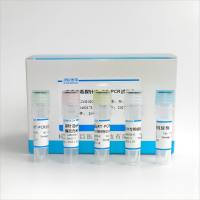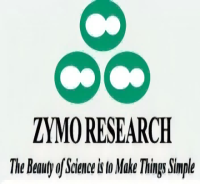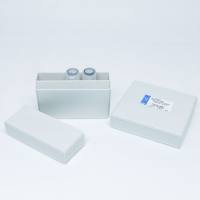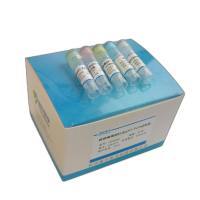PCR amplification of variable regions (SOE-Protocol)
丁香园论坛
1926
来自该网站:http://www.archimedes.rwth-aachen.de/MolbioProtocols/Phage%20Display/PCR%20amplification%20of%20variable%20regions%20(SOE-Protocol).html
The SOE-Protocol given below utilises our initial set of primers for mouse and chiocken phage display wherby the amplified VH and VL are connected by a primer encoded (Gly4Ser)3-linker.
For the amplification of the variable regions, three different murine primer sets can be used:
VH front (MuPD 3, 4, 5, 6, 7. 8. 9. 10, 11 and 12, mix) and VH back (MuPD 34, 35, 36 and 37, mix) for VH amplification, CPDVHF and CPD VH Gly for chicken VH.
VK front (MuPD 19, 20, 21, 22, and 23, mix) and VK back (MuPD 27, 28 and 29, mix) for VK amplification, CPDVLF and CPD VL Ser for chicken VL.
Vlambda front (MuPD 26) and Vlambda back (MuPD 30) for Vlambda amplification.
Every PCR amplification of variable regions was done using 4 to 10 µl of the first strand reaction.
Set up the following PCR reactions (50 µl total volume each, combine 10 pM of forward primer with a total of 10 to max 20 pM of a mixture of all backward primers):
VH amplification from G1 first strand
5-10 µl first-strand reaction (with COH 30 primer)
2 µl VH front primer (10 pmol/µl stock)
2 µl VH back primer mix (10 -20 pmol/µl stock)
2,5 µl DMSO
4 to 4.5 µl PCR 10x buffer
3 µl MgCl2, 25 mM
0,3 µl Taq-polymerase (5U/µl)
ad 50 µl Water
VH amplification from G2a/2b first strand
5-10 µl first-strand reaction (with COH 32 primer)
2 µl VH front primer (10 pmol/µl stock)
2 µl VH back primer mix (10 -20 pmol/µl stock)
2,5 µl DMSO
4 to 4.5 µl PCR 10x buffer
3 µl MgCl2, 25 mM
0,3 µl Taq-polymerase (5U/µl)
ad 50 µl Water
Vkappa amplification from kappa first strand
5-10 µl first-strand reaction (with MuPD 31 primer)
2 µl VH front primer (10 pmol/µl stock)
2 µl VH back primer mix (10 -20 pmol/µl stock)
2,5 µl DMSO
4 to 4.5 µl PCR 10x buffer
3 µl MgCl2, 25 mM
0,3 µl Taq-polymerase (5U/µl)
ad 50 µl Water
Vlambda amplification from lambda first strand
5-10 µl first-strand reaction (with MuPD 31 primer)
2 µl VH front primer (10 pmol/µl stock)
2 µl VH back primer mix (10 -20 pmol/µl stock)
2,5 µl DMSO
4 to 4.5 µl PCR 10x buffer
3 µl MgCl2, 25 mM
0,3 µl Taq-polymerase (5U/µl)
ad 50 µl Water
Start the following program:
5 min 95°C
then 30 times:
40s 95°C
2 min 58°C
2 min 72°C
final:
5 min 72°C
Check reactions putting 5 µl on a 1,2 % agarose gel.
Purify amplified variable regions by agarose gel (1,2 %) electrophoresis and Gelclean (Macherey Nagel): Load each PCR reaction in one slot of 40 µl, store the remaining 5 µl PCR reaction at -20°C. Later, this can be used for reamplification, if necessary. Cut out the right bands and purify. Two elutions can be done with 30 µl Tris/EDTA buffer, the two elutions are combined (±55 µl final volume per PCR reaction). Check purifications, putting 3 µl of each purification on a 1,2% agarose gel. Calculate the concentration of each purified PCR product.
Making scFv's by SOE-PCR
In the SOE-PCR the VH and VL regions are combined randomly by their overlapping linker region. We choose to mix equal amounts of variable regions from heavy chain (G1, G2a/2b, mix 50:50), and light chain (K and lambda regions, mix 95:5). In the 'second step PCR' the synthesized scFv encoding sequences from the SOE-PCR are amplified using two primer mixes: univ VH (MuPD 18) and univ VL (MuPD 33). Finally, these scFv sequences contain SfiI and NotI restriction sites at their borders, so they can be cloned in the phage display vector pHEN1. It is very!!! important to combine equal amounts of variable heavy and light regions for the SOE-PCR. We had good results using 12,5 ng of each variable region, that means 50 ng variable regions in total per SOE. The amount of SOE-PCRs that can be done with the purified variable regions is limited by the variable region with the lowest purification yield. Using more variable regions than 12,5 ng can give more scFv product, but then you can do less SOE-PCRs. Each SOE-PCR can be divided in five second step PCRs.
For each SOE-PCR, mix the following components:
x µl VH G1
x µl VH G2
x µl VK
x µl Vlambda
3 µl MgCl2
5 µl PCR buffer
4 µl 2,5 mM dNTP
0,2 µl Taq polymerase
x µl H20
50 µl Total volume
Add 50 µl mineral oil and run the following program in the thermocycler (7 cycles):
5 min 95°C
2 min 55°C
10 min 72°C
For the second step PCR, mix the following components:
10 µl SOE-PCR
4 µl PCR buffer
2,4 µl MgCl2
4 µl 2,5 mM dNTP
0,25 µl univ VH primer (10 pM)
0,25 µl univ VL primer (10 pM)
0,2 µl Taq polymerase
28,9 µl H20
50 µl Total volume
Note: using 10 pmole of each primer instead of 2,5 pmole gave an additional PCR product at ±400 bp!!!
Add 50 µl mineral oil and run the following program in the thermocycler:
15 min 95°C
then 30 times:
2 min 60°C
3 min 72°C
1 min 94°C
final:
2 min 60°C
10 min 72°C
Check the PCR reaction(s) by running 5 µl PCR reaction on a 0,8% agarose gel.
Purification of the scFv fragments
The scFv fragments are purified from the PCR reaction by special gel filtration, using S-400 sephacryl columns from PHARMACIA (Cat. No. 27-5140-01). These columns take out primers and other PCR material. It is much faster than gel purification. Besides, gel purification can give bad ligation efficiency.
Combine all second step PCR reactions and add 1 µl protease K to release any Taq, sticking to the DNA and incubate for 30 min at 50°C
Add 1 vol PCI, vortex shortly, centrifuge 5 min in microcentrifuge, take off superna-tant and purify the scfv fragments in the supernatant through a S-400 sephacryl micros-pin column:
a. vortex the micro-spin column to homogenize
b. screw off the top cap but leave it on
c. break off the bottom cap
d. put the column in a eppendorf tube and spin for 1 min at 735 xg
e. pipet the supernatant on the top of the resin, do not touch the resin.
f. spin 2 min at 735 xg, remove the column
g. spin the eluate 5 min at topspeed to remove remaining resin
h. Pipet the supernatant in a new eppendorf
Note: Do one column purification for each two second step PCRs (a. 100 µl).
Before doing the restriction digest, the purified scFv was concentrated by precipitation:
a. Pool scFv purifications
b. Add 1/10 volume 2M NaCl and 3 volumes ice cold ethanol
c. Incubate overnight at -20°C
d. Centrifuge 10 min topspeed in a microcentrifuge at 4°C
e. Take off supernatant
f. Wash the pellet(s) with 200 µl 70% ethanol (roomtemp)
g. Spin 5 min at roomtemp, topspeed
h. Take off supernatant
i. Dissolve the pellet(s) in 10 µl H20.
The SOE-Protocol given below utilises our initial set of primers for mouse and chiocken phage display wherby the amplified VH and VL are connected by a primer encoded (Gly4Ser)3-linker.
For the amplification of the variable regions, three different murine primer sets can be used:
VH front (MuPD 3, 4, 5, 6, 7. 8. 9. 10, 11 and 12, mix) and VH back (MuPD 34, 35, 36 and 37, mix) for VH amplification, CPDVHF and CPD VH Gly for chicken VH.
VK front (MuPD 19, 20, 21, 22, and 23, mix) and VK back (MuPD 27, 28 and 29, mix) for VK amplification, CPDVLF and CPD VL Ser for chicken VL.
Vlambda front (MuPD 26) and Vlambda back (MuPD 30) for Vlambda amplification.
Every PCR amplification of variable regions was done using 4 to 10 µl of the first strand reaction.
Set up the following PCR reactions (50 µl total volume each, combine 10 pM of forward primer with a total of 10 to max 20 pM of a mixture of all backward primers):
VH amplification from G1 first strand
5-10 µl first-strand reaction (with COH 30 primer)
2 µl VH front primer (10 pmol/µl stock)
2 µl VH back primer mix (10 -20 pmol/µl stock)
2,5 µl DMSO
4 to 4.5 µl PCR 10x buffer
3 µl MgCl2, 25 mM
0,3 µl Taq-polymerase (5U/µl)
ad 50 µl Water
VH amplification from G2a/2b first strand
5-10 µl first-strand reaction (with COH 32 primer)
2 µl VH front primer (10 pmol/µl stock)
2 µl VH back primer mix (10 -20 pmol/µl stock)
2,5 µl DMSO
4 to 4.5 µl PCR 10x buffer
3 µl MgCl2, 25 mM
0,3 µl Taq-polymerase (5U/µl)
ad 50 µl Water
Vkappa amplification from kappa first strand
5-10 µl first-strand reaction (with MuPD 31 primer)
2 µl VH front primer (10 pmol/µl stock)
2 µl VH back primer mix (10 -20 pmol/µl stock)
2,5 µl DMSO
4 to 4.5 µl PCR 10x buffer
3 µl MgCl2, 25 mM
0,3 µl Taq-polymerase (5U/µl)
ad 50 µl Water
Vlambda amplification from lambda first strand
5-10 µl first-strand reaction (with MuPD 31 primer)
2 µl VH front primer (10 pmol/µl stock)
2 µl VH back primer mix (10 -20 pmol/µl stock)
2,5 µl DMSO
4 to 4.5 µl PCR 10x buffer
3 µl MgCl2, 25 mM
0,3 µl Taq-polymerase (5U/µl)
ad 50 µl Water
Start the following program:
5 min 95°C
then 30 times:
40s 95°C
2 min 58°C
2 min 72°C
final:
5 min 72°C
Check reactions putting 5 µl on a 1,2 % agarose gel.
Purify amplified variable regions by agarose gel (1,2 %) electrophoresis and Gelclean (Macherey Nagel): Load each PCR reaction in one slot of 40 µl, store the remaining 5 µl PCR reaction at -20°C. Later, this can be used for reamplification, if necessary. Cut out the right bands and purify. Two elutions can be done with 30 µl Tris/EDTA buffer, the two elutions are combined (±55 µl final volume per PCR reaction). Check purifications, putting 3 µl of each purification on a 1,2% agarose gel. Calculate the concentration of each purified PCR product.
Making scFv's by SOE-PCR
In the SOE-PCR the VH and VL regions are combined randomly by their overlapping linker region. We choose to mix equal amounts of variable regions from heavy chain (G1, G2a/2b, mix 50:50), and light chain (K and lambda regions, mix 95:5). In the 'second step PCR' the synthesized scFv encoding sequences from the SOE-PCR are amplified using two primer mixes: univ VH (MuPD 18) and univ VL (MuPD 33). Finally, these scFv sequences contain SfiI and NotI restriction sites at their borders, so they can be cloned in the phage display vector pHEN1. It is very!!! important to combine equal amounts of variable heavy and light regions for the SOE-PCR. We had good results using 12,5 ng of each variable region, that means 50 ng variable regions in total per SOE. The amount of SOE-PCRs that can be done with the purified variable regions is limited by the variable region with the lowest purification yield. Using more variable regions than 12,5 ng can give more scFv product, but then you can do less SOE-PCRs. Each SOE-PCR can be divided in five second step PCRs.
For each SOE-PCR, mix the following components:
x µl VH G1
x µl VH G2
x µl VK
x µl Vlambda
3 µl MgCl2
5 µl PCR buffer
4 µl 2,5 mM dNTP
0,2 µl Taq polymerase
x µl H20
50 µl Total volume
Add 50 µl mineral oil and run the following program in the thermocycler (7 cycles):
5 min 95°C
2 min 55°C
10 min 72°C
For the second step PCR, mix the following components:
10 µl SOE-PCR
4 µl PCR buffer
2,4 µl MgCl2
4 µl 2,5 mM dNTP
0,25 µl univ VH primer (10 pM)
0,25 µl univ VL primer (10 pM)
0,2 µl Taq polymerase
28,9 µl H20
50 µl Total volume
Note: using 10 pmole of each primer instead of 2,5 pmole gave an additional PCR product at ±400 bp!!!
Add 50 µl mineral oil and run the following program in the thermocycler:
15 min 95°C
then 30 times:
2 min 60°C
3 min 72°C
1 min 94°C
final:
2 min 60°C
10 min 72°C
Check the PCR reaction(s) by running 5 µl PCR reaction on a 0,8% agarose gel.
Purification of the scFv fragments
The scFv fragments are purified from the PCR reaction by special gel filtration, using S-400 sephacryl columns from PHARMACIA (Cat. No. 27-5140-01). These columns take out primers and other PCR material. It is much faster than gel purification. Besides, gel purification can give bad ligation efficiency.
Combine all second step PCR reactions and add 1 µl protease K to release any Taq, sticking to the DNA and incubate for 30 min at 50°C
Add 1 vol PCI, vortex shortly, centrifuge 5 min in microcentrifuge, take off superna-tant and purify the scfv fragments in the supernatant through a S-400 sephacryl micros-pin column:
a. vortex the micro-spin column to homogenize
b. screw off the top cap but leave it on
c. break off the bottom cap
d. put the column in a eppendorf tube and spin for 1 min at 735 xg
e. pipet the supernatant on the top of the resin, do not touch the resin.
f. spin 2 min at 735 xg, remove the column
g. spin the eluate 5 min at topspeed to remove remaining resin
h. Pipet the supernatant in a new eppendorf
Note: Do one column purification for each two second step PCRs (a. 100 µl).
Before doing the restriction digest, the purified scFv was concentrated by precipitation:
a. Pool scFv purifications
b. Add 1/10 volume 2M NaCl and 3 volumes ice cold ethanol
c. Incubate overnight at -20°C
d. Centrifuge 10 min topspeed in a microcentrifuge at 4°C
e. Take off supernatant
f. Wash the pellet(s) with 200 µl 70% ethanol (roomtemp)
g. Spin 5 min at roomtemp, topspeed
h. Take off supernatant
i. Dissolve the pellet(s) in 10 µl H20.









